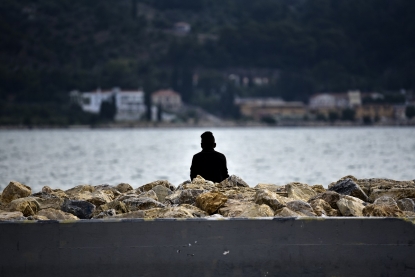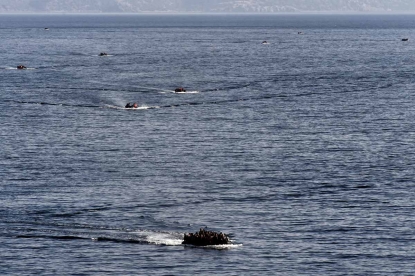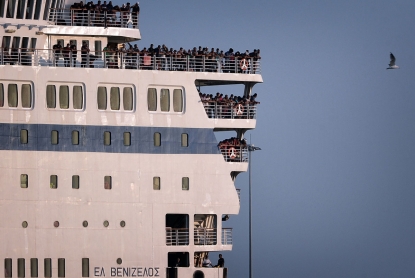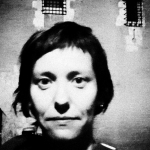The endless wait
Samos, Greece -- Before there was hope because people were on their way to a new life. Now there is resignation and exhaustion because people are stuck here and they don’t know when they’ll leave.
 A migrant watches the sea at Samos' island capital city of Vathy on June 18, 2019. (AFP / Louisa Gouliamaki)
A migrant watches the sea at Samos' island capital city of Vathy on June 18, 2019. (AFP / Louisa Gouliamaki)The migrant crisis may have disappeared from the world’s top news stories, but it is still ever-present in Greece, where I have covered it since the beginning.
In many ways, you can’t compare the situation today to what we had in 2015, the peak of the emergency.
Back then, thousands of people arrived each day by boats on islands like Lesbos and Samos, many of them fleeing conflicts in Syria, Afghanistan and Iraq.
 Dinghies filled with refugees dot the sea as they approach Lesbos after crossing the Aegean Sea from Turkey, October 4, 2015.
(AFP / Aris Messinis)
Dinghies filled with refugees dot the sea as they approach Lesbos after crossing the Aegean Sea from Turkey, October 4, 2015.
(AFP / Aris Messinis)Back then, it was chaos.
 A bird flies past as migrants stand on the hull of the Greek government-chartered Eleftherios Venizelos ferry upon their arrival at the port of Piraeus on August 21, 2015. (AFP / Louisa Gouliamaki)
A bird flies past as migrants stand on the hull of the Greek government-chartered Eleftherios Venizelos ferry upon their arrival at the port of Piraeus on August 21, 2015. (AFP / Louisa Gouliamaki) Refugees and migrants disembark from a ferry from Lesbos island in the port of Piraeus on October 6, 2015. (AFP / Louisa Gouliamaki)
Refugees and migrants disembark from a ferry from Lesbos island in the port of Piraeus on October 6, 2015. (AFP / Louisa Gouliamaki)
You had people living everywhere in the streets. Everywhere you looked there were families, young men, old people.
 Families sleep at an Athens central square where hundreds of mainly Afghani refugees have found temporary shelter, without running water or toilets, on September 10, 2015. (AFP / Louisa Gouliamaki)
Families sleep at an Athens central square where hundreds of mainly Afghani refugees have found temporary shelter, without running water or toilets, on September 10, 2015. (AFP / Louisa Gouliamaki)Many only stayed for a short while before continuing on to other countries in Europe, especially Germany.
 Migrants make their way towards the Greek-FYR Macedonian borders as the sun rises on September 5, 2015. (AFP / Louisa Gouliamaki)
Migrants make their way towards the Greek-FYR Macedonian borders as the sun rises on September 5, 2015. (AFP / Louisa Gouliamaki)Today the situation is much more orderly. Most people are living in camps set up for them by aid groups and in the overflow areas around them. On the island of Samos, for example, the main camp, which we call “the hot spot,” was designed for 650 people. Today, 3,700 people are living there, with dozens of tents set up outside to contain the overflow.
 A migrant walks to take a shower at the makeshift refugee camp above the city of Vathy on the island of Samos early on June 18, 2019. (AFP / Louisa Gouliamaki)
A migrant walks to take a shower at the makeshift refugee camp above the city of Vathy on the island of Samos early on June 18, 2019. (AFP / Louisa Gouliamaki) A migrant woman prepares tea at the makeshift refugee camp, staged next to the island's hotspot above the city of Vathy, on the island of Samos early on June 18, 2019. (AFP / Louisa Gouliamaki)
A migrant woman prepares tea at the makeshift refugee camp, staged next to the island's hotspot above the city of Vathy, on the island of Samos early on June 18, 2019. (AFP / Louisa Gouliamaki)
When I visited Samos recently ahead of national elections, a newly-arrived family from Afghanistan was setting up camp. They’d gotten to Samos only two days before, the two parents with five young children. The kids were trying to help set up a tarp to protect them against the rain. It was heartwarming and heartbreaking at the same time. Seeing the kids helping their parents make their shelter in this new land, so different from their home up till now. And knowing that they’ll likely end up living months and maybe even years in this tent as they await their asylum application to be processed.
 Migrants walk out the refugee camp at Samos' island capital city of Vathy on June 18, 2019. (AFP / Louisa Gouliamaki)
Migrants walk out the refugee camp at Samos' island capital city of Vathy on June 18, 2019. (AFP / Louisa Gouliamaki)People continue to arrive on Greek islands. It’s not a deluge as before, but it’s a steady stream. In May, we had some 3,000 people arrive on the islands, which today house more than 15,800 people. That’s about 100 hundred people per day on average.
But if before the islands were a transit point, today people are stuck on them.
 A migrant prays next to a German frontex boat at Samos island capital city of Vathy on June 18, 2019. (AFP / Louisa Gouliamaki)
A migrant prays next to a German frontex boat at Samos island capital city of Vathy on June 18, 2019. (AFP / Louisa Gouliamaki)The presence of so many people with no jobs and language living in less than ideal conditions is causing some anxiety among the locals. When I spoke to the locals on Samos, no-one told me they were against them being there and no-one was talking about crime, because this has not gone up with the arrival of the refugees.
But there is a lot of unease and anxiety because the locals feel their town is no longer theirs. Toward the evening, when the heat drops and people usually come outside, you’ll have single men sitting in children’s playgrounds, for example. You can understand the men, they don’t have much to do or someplace to go. But the locals don’t take their children to their playground. “We don’t know them, so it’s better to stay away,” lots of them told me.
 Migrants sit near a playground at Samos island capital city of Vathy late on June 19, 2019. (AFP / Louisa Gouliamaki)
Migrants sit near a playground at Samos island capital city of Vathy late on June 19, 2019. (AFP / Louisa Gouliamaki)On the side of the refugees, there is frustration. I talked to one family from Syria, a woman with two small children who has been on Samos for one year and seven months. She is lucky in that she is living in an apartment provided to her by the UN refugee agency. Her ultimate goal is to get to Germany, where she has family. It’s very difficult for her to be on this small island where she doesn’t speak the language by herself with two small kids.
Another Syrian family, parents with three children, has been living in the hot spot for a year and a half. They smiled when they spoke to me and made the best of their situation, but their conditions aren’t great. They are tired and there is this feeling of uncertainty. They’re stuck in a foreign country, where they don’t speak the language, where they don’t have family, where their children can’t go to school. And they don’t know when or if they’ll leave.
 Local children play by a refugee family on a central square of Samos' island capital city of Vathy on June 19, 2019. (AFP / Louisa Gouliamaki)
Local children play by a refugee family on a central square of Samos' island capital city of Vathy on June 19, 2019. (AFP / Louisa Gouliamaki)The situation for migrants in Athens is better. They’re more integrated in the capital. Their children go to school. While most people who came here wanted to leave Greece, some have decided to stay. They’ve learned the language, maybe they’ve found a job. But most still want to go on to another western European country.
While on the islands the refugee question is one of the main topics, in Athens and other large cities, it wasn’t really part of the discussion ahead of the elections.
People are aware of it of course -- we have nearly 80,000 refugees and migrants living in our country and more are arriving every month. But it’s not an urgent question.
 A migrant from Syria holds his baby as they arrived on the island of Lesbos, early on June 18, 2015. (AFP / Louisa Gouliamaki)
A migrant from Syria holds his baby as they arrived on the island of Lesbos, early on June 18, 2015. (AFP / Louisa Gouliamaki) A Syrian mother tries to warm up her daugter after they arrived on the island of Lesbos, early on June 18, 2015. (AFP / Louisa Gouliamaki)
A Syrian mother tries to warm up her daugter after they arrived on the island of Lesbos, early on June 18, 2015. (AFP / Louisa Gouliamaki)
It’s difficult to say how the situation will evolve. A lot will depend on the conflicts in the Middle East and beyond. People will continue to seek a better future for themselves and their children, it’s just what people do. And even if you wanted to, you can’t close the sea.
The blog was written with Yana Dlugy in Paris.
 Migrant youth sit by a local fisherman at the city of Vathy on the island of Samos on June 19, 2019. (AFP / Louisa Gouliamaki)
Migrant youth sit by a local fisherman at the city of Vathy on the island of Samos on June 19, 2019. (AFP / Louisa Gouliamaki) A Syrian migrant flashes the V-sign after swimming to the shores of the Greek Aegean island of Kos from a small half-sunk dinghy on August 17, 2015. (AFP / Louisa Gouliamaki)
A Syrian migrant flashes the V-sign after swimming to the shores of the Greek Aegean island of Kos from a small half-sunk dinghy on August 17, 2015. (AFP / Louisa Gouliamaki)


